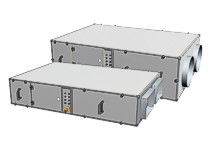In the face of growing pressures for building services engineers, public, commercial and leisure sector end-users to cut carbon emissions and reduce energy costs, Vent-Axia has introduced the Sentinel Totus D-ERV (Demand Energy Recovery Ventilation) system:

Vent-Axia's Sentinel Totus integrates the company's proven on-demand control concept with efficient EC/DC motor technology and what is claimed to be a state-of-the-art counterflow heat recovery cell to achieve up to 90% energy recovery. This, says the company, is the highest performance of any system on the market. It is also the UK's first D-ERV system to be independently rated and tested to EN308.
Sentinel Totus operates on the principles of on-demand ventilation. It responds to the precise ventilation requirements of a room at any one time providing the right level of supply and extract airflow only when required, making it ideal for schools, hotels, theatres, offices and other environments with changing occupancy patterns. Sentinel Totus also recovers maximum energy (heat and cool) from the extracted air, transferring it into the fresh air supply via the unit's integral high efficiency counterflow heat exchanger. The result is a system which achieves required airflow rates and ventilates according to precise needs, significantly reducing fuel consumption, energy costs and cutting the carbon footprint of a building by up to 30% more than conventional crossflow energy recovery ventilation devices.
Response to room occupancy:
The system's on-demand operation can be triggered by its response to room occupancy according to a range of different sensor readings. These can include PIR occupancy detection, to activate the unit, with additional proportional airflow control from a combination of sensors, CO2, humidity or temperature. These sensors communicate with the main Sentinel Totus unit, which - in turn - drives the fan to the required speed to deliver the airflow and respond precisely to room conditions. Sensors can be combined to generate a hierarchy of control for the ventilation system and ventilation system operation can also be easily linked in to a Building Management System via volt free contacts for monitoring, if required.
Sentinel Totus also incorporates energy efficient EC/ DC motor technology, which is proven to use over 30% less energy than conventional AC motors. Automatic air-conditioning and heating interlocks enable this D-ERV product to optimise energy recovery performance further and provide free cooling during summer through bypass optimisation. A user enabled night-time purge facility can reduce the start up loads for a building's air-conditioning plant, and helps reduce overheating in summer from non air conditioned spaces.
Meeting the requirements of Building Regulations Part L2A and L2B, Sentinel Totus achieves a specific fan power at 25% of design flow rate, no greater than that achieved at 100% design flow rate. It will also help end-users ensure that their buildings meet EU demands to the 20% cut in energy consumption by 2010 targeted by the EPBD.
Sentinel Totus D-ERV is part of Vent-Axia's award-winning Sentinel demand ventilation range for commercial and residential applications. It is also part of the company's Lo-Carbon collection of energy saving ventilation solutions. The aim of the Lo-Carbon initiative is to offer the latest low carbon ventilation technology in order to reduce building energy consumption and so carbon emissions.
For further information on all products and services offered by Vent-Axia telephone 01293 441616 or visit www.vent-axia.com.